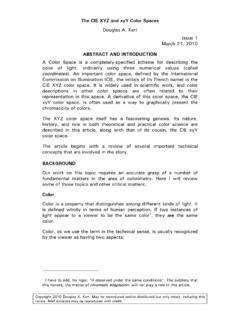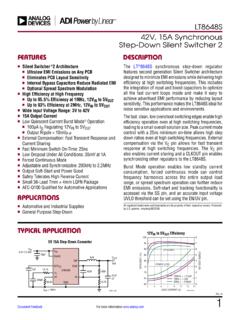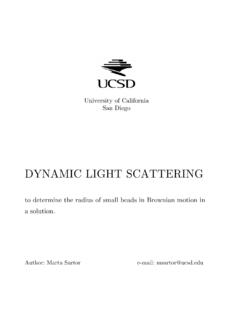Transcription of Solar Cell Voltage-Current Characterization
1 Solar Cell Voltage Current Characterization Introduction A Solar cell is a semiconductor PN junction diode, normally without an external bias, that provides electrical power to a load when illuminated (Figure 1). PNSunlightLoad+_ Figure 1. The basic Solar cell structure. Typical Voltage-Current characteristics, known as the IV curve, of a diode without illumination is shown in green in Figure 2. The applied potential is in the forward bias direction. The curve shows the turn-on and the buildup of the forward bias current in the diode. Without illumination, no current flows through the diode unless there is external potential applied.
2 With incident sunlight, the IV curve shifts up and indicates that there is external current flow from the Solar cell to a passive load. VIDarkMore Light Figure 2. The progression of the Solar cell IV curve as the incident light increases. Short circuit current, Isc, flows with zero external resistance (V= 0) and is the maximum current delivered by the Solar cell at any illumination level. Similarly, the open circuit voltage, Voc, is the potential that develops across the terminals of the Solar cell when the external load resistance is very large (Figure 3). The power delivered to the load is of course zero at both extremes and reaches a maximum (Pmax) at a finite load resistance value.
3 In Figure 3, Pmax is shown as the area of the shaded rectangle. VIIscVocPma x Figure 3. The maximum power delivered by the Solar cell, Pmax, is the area of the largest rectangle under the IV curve. A commonly used number that characterizes the Solar cell is the fill factor, FF, which is defined as the ratio of Pmax to the area of the rectangle formed by Voc and Isc. ))((maxIscVocPFF=. (1) Efficiency The efficiency of a Solar cell is the ratio of the electrical power it delivers to the load, to the optical power incident on the cell. Maximum efficiency is when power delivered to the load is Pmax. Incident optical power is normally specified as the Solar power on the surface of the earth which is approximately 1mW/mm2.
4 Spectral distribution of sunlight is close to a blackbody spectrum at 6000 C minus the atmospheric absorption spectrum as shown in Figure ( ). Using expression (1), maximum efficiency may be written as: ininPFFIscVocPP))()((maxmax== . (2) Isc is directly proportional to the incident optical power Pin. But Voc also increases logarithmically with the incident power. So the overall efficiency of the Solar cell is expected to increase logarithmically with incident power. However, at high sunlight concentration thermal effects and electrical losses in the series resistance of the Solar cell limit the efficiency enhancement that can be achieved.
5 So the efficiency of practical Solar cells peaks at some finite concentration level. Other Parameters Among other significant parameters of the Solar cell that can be extracted from the IV curves are the equivalent series and parallel resistances. Figure 4 shows the simplified equivalent circuit model of a Solar cell. The value of the series resistance Rs, is typically much lower than the parallel resistance Rp (sometimes referred to as the shunt resistance Rsh). For the ideal Solar cell, Rs would be zero, and Rp would be infinite. Since the effect of Rs is negligible near open circuit conditions, the slope of the IV curve in that vicinity is an indicator of the value of Rp.
6 Conversely, since the effect of Rp is negligible near short circuit conditions, the slope of the curve in that vicinity is an indicator of the value of Rs. If the illumination applied to the Solar cell during the IV test is representative of the Solar radiation it receives in the field, then the maximum efficiency of the Solar cell may be calculated as the ratio of Pmax to the optical power incident on the Solar cell. Figure 4. A simplified equivalent circuit model of the Solar cell. Each point on the IV curve corresponds to a load resistance (VL IL) and a power delivered to the load (VL . IL). So the IV curve can easily be converted to a power vs resistance curve (Figure 5).
7 This plot directly shows the maximum power, Pmax, that the Solar cell can deliver to a load, and the value of load resistance needed for the maximum power transfer. Figure 5. The information contents of the IV curve and the power vs load resistance curve are the same and the two plots can be converted to each other. Measurement Apparatus A common laboratory method of characterizing the Voltage-Current characteristics of Solar cells is to use a parameter analyzer that employs measurement ports known as Source-Measurement Units (SMUs). Each SMU is capable of providing a known voltage and measuring the resulting current or vice versa. Parameter analyzers with SMUs are widely used for characterizing diodes and transistors.
8 In order to measure the Voltage-Current characteristics of a Solar cell under illumination, typically the SMU is stepped through various current limiting levels and the corresponding voltages are measured. The parameter analyzer is also capable of testing the reverse biased portion of the IV curve by applying a reverse bias voltage to the cell and measuring the resulting current. One limitation of the SMU method is that a typical SMU has a maximum current limit of 100 mA. Variable Load Method Even though the parameter analyzer or the SMU method makes fast and accurate IV curve measurements, it may be cumbersome to use in the field.
9 An alternative measurement method that allows portability and low cost is known as the Variable Load method and may be used to characterize any active device that delivers electrical power to the load. The concept is very simple and direct. Instead of measuring current as a function of voltage, and then converting to power as a function of load, it measures the power as a function of load directly (Figure 5). The test system presents a variable resistive load to the source under test. The variable load includes the short circuit and open circuit conditions and steps through many intermediate resistance values. It measures the voltage and current across the load at each value of load resistance.
10 The collected information is sufficient to plot all the characteristic curves discussed above and to extract all the listed parameters.







